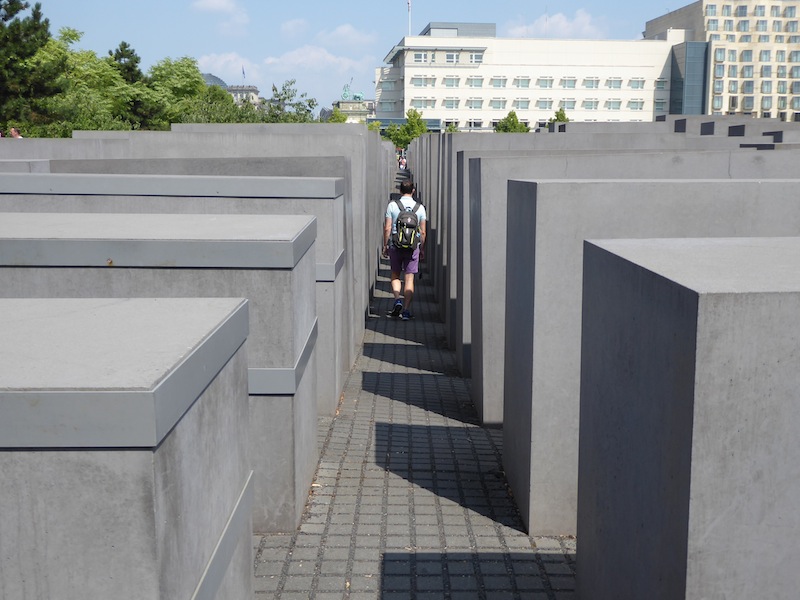From the top of the Panoramapunkt viewing platform at Potsdamer Platz, it’s easy to see the grey slabs of Berlin’s Holocaust memorial on Ebertstrasse far below.
The memorial was something I’d put on my ‘to see’ list because it was still being built when we were last in the city back in January 2004. This was my first glimpse of it, and its size took me completely by surprise.
We would go on to explore it up close but first, and with just a few hours to spare before our flight home from Tegel Airport, we took the lift up to that viewing platform. The Panoramapunkt has the fastest in Europe, and it whisked us 100m into the air in a matter of seconds.
The platform crowns the red-brick Kollhoff Tower, one of the many stylish contemporary blocks that make up the modern Potsdamer Platz, and one that has a New York feel about it.

The views were very good indeed. I could see planes landing in the far distance at Tegel, the vast expanse of the Tiergarten and, out to the east, the majestic Fernsehturm TV tower at Alexanderplatz. It struck us both that Berlin has very few of the towering skyscrapers that are such a feature of the cityscapes of New York, Dubai and even London. Some photos of Potsdamer Platz from before the war gave us an idea of how the area once looked.
Back at ground level I tried to warm to the new Potsdamer Platz, but while the buildings are interesting (many were still being developed back in 2004), the district is a bit sterile. True, it was a Monday morning and there weren’t too many people around, but the mix of big global chains, steel and glass gave it the air of a shopping mall, and one that I could find anywhere in the world. There were few reminders of the time when this was one of the most notorious and scarred districts of the divided, post-war Berlin, other than a few slabs of the Berlin Wall.

We’d visited the Sony Centre the last time we were in Berlin and liked the architecture, as well as the way the remains of the venerable Hotel Esplanade had been incorporated into the structure. We returned for a quick nose around and then in the sticky heat walked up Ebertstrasse, once divided by the Berlin Wall, to the curious and controversial holocaust memorial officially known as the Memorial to the Murdered Jews of Europe.
It’s made up of 2,711 beautifully polished concrete slabs of varying heights, arranged in a grid pattern on a gently undulating piece of land.
It’s a striking work, designed by Peter Eisenman, and we wandered solemnly up and down the narrow passages, taking advantage of the shade, pondering the memorial’s meaning.

Many kids were running around playing hide and seek, other visitors snapped away furiously on their phones. And I wondered just how many of them were really able to grasp the significance of what they were looking at. Perhaps I was being too sensitive, but it didn’t seem to me a place for laughter and games and selfies.
Still, I didn’t get what the designer was trying to say with the slabs, and the memorial didn’t have the emotional impact I was expecting it to. Perhaps that was in part because the accompanying exhibition was closed, it being a Monday. Eisenman said he set out to create an uneasy and confusing atmosphere, and a supposedly ordered system that’s lost touch with human reason.
After refreshments, we crossed the road to the edge of the Tiergarten to see the Memorial to the Homosexuals Persecuted under the National Socialist Regime.

It reflects the style of the Jewish memorial but is just one giant polished grey slab, leaning slightly. It was quieter there and we peered into a little screen built into the concrete and viewed a symbolic and poignant film of two men kissing.
Bunches of flowers lay beside it, no doubt left by visitors to the Christopher Street Day celebrations a few days earlier.
Feeling suitably sombre, we marched off to collect our bags from the Hotel Indigo and caught the bus to Tegel, our visit over. Perhaps it was only right that we ended up at the memorial to gay victims of Nazi oppression because Berlin is undoubtedly one of the most inclusive and welcoming cities that I’ve been to. And I definitely want to return.

